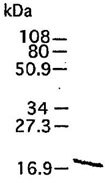Brunner, K.L, et al. 1995. Proc. Natl. Acad. Sci. USA 92, 7362.
Imai, K., et al. 1995. J. Biol. Chem. 270, 6691.
Lichtinghagen, R., et al. 1995. Eur. J. Clin. Chem. Clin. Biochem. 33, 65.
Nakano, A., et al. 1995. J. Neurosurg. 83, 298.
Takino, T., et al. 1995. J. Biol. Chem. 270, 23013.
Woessner, J.F., Jr., 1995. Meth. Enzymol. 248, 485.
Yamamoto, H., et al. 1995. J. Clin. Lab. Anal. 9, 297.
Gaire, M., et al. 1994. J. Biol. Chem. 269, 2032.
Woessner, J.F., Jr., 1995. Meth. Enzymol. 248, 485.
Cottam, D. W. and Rees, R. C., 1993. Intl J. Oncol. 2, 861.
Stetler-Stevenson, W. G., et al. 1993. FASEB J. 7, 1434.
Woessner, J. F., 1991. FASEB J. 5, 2145.
Liotta, L. A. and Stetler-Stevenson, W. G., 1990. in Sem. Cancer Biol., ed. M. M. Gottesman. Vol. 1(2), 99.
Woessner, J.F., Jr and Taplin, C.J., 1988. J. Biol. Chem. 263, 16918.
Sellers, A and Woessner, J.F., Jr., 1980. Biochem. J. 189, 521. |








